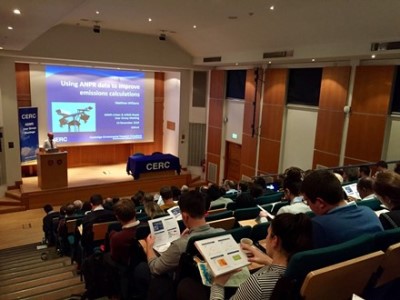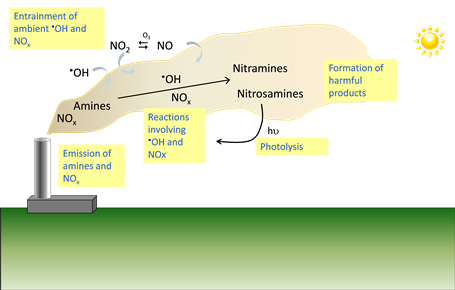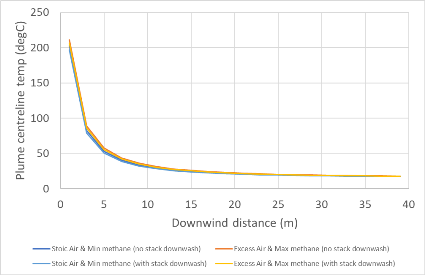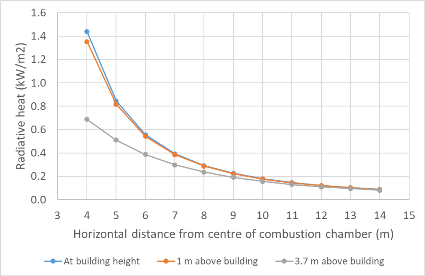CERC news
< Previous12345678910111213141516171819Next >

10 Aug 2022Booking is now open for the ADMS User Group Meetings, 16-17 November 2022, Birmingham
You can now book your tickets for the 2022 ADMS User Group Meetings, which will be held at IET Birmingham: Austin Court on 16th and 17th November.
The annual ADMS User Group Meetings are a great opportunity to hear the latest ADMS model news and advice from CERC consultants and model developers, to hear talks by model users about their own applications of the software, and to network with other model users.
Tickets are available to order through Eventbrite until 23:30 on Tuesday 8th November. Organisations with a valid software support contract are entitled to one or more tickets free of charge depending on the type of licence held. The draft programme will be published soon.

13 Jul 2022Amine chemistry modelling in ADMS for carbon capture and storage
CERC are a partner in this ground-breaking SCOPE project (Sustainable OPEration of post-combustion Capture plants) to accelerate large scale CO2-capture projects by providing critical data, methodologies and tools, essential for plant owners and regulators engaged in managing emissions and permitting processes.
A goal is to establish methods and rules for risk assessment of flue gas emissions from CO2-capture facilities. CERC’s role will be to further develop the chemistry model for amine degradation and formation of nitrosamines and nitramines, within the ADMS dispersion model, to allow for multiple sources, multiple amine species and uptake of amines into the aqueous phase. We will also assist Imperial College and other partners in testing and applying the modelling system to amine releases at test sites. This will result in improved prediction of the impacts of amine emissions from CO2-capture solvents for the permitting process.
Other key activities in the project comprise development of knowledge for determining volatile and aerosol-based emissions, including development of technology for minimising emissions, and the creation of tools for online emission measurements. These will be aided by pilot demonstration of emission mitigation technologies at six test sites and implementation of online emission measurement equipment. Another goal is to map the public concerns in diverse countries and regions in terms of the social, environmental, economic, and political impacts of amine-based Carbon Capture, Utilisation and Storage (CCUS) developments.
This work will be undertaken by an international consortium of key science, technology and policy experts, and stakeholders in Norway, UK, Netherlands, Germany, India and USA. In the UK, the project is led by the Imperial College Department of Earth Sciences and Engineering and funded by BEIS; the overall project leader is SINTEF of Norway.
CERC are pleased to announce that EMIT 3.9 is now available from the CERC website user area.
EMIT is our comprehensive tool for compiling and editing emissions inventories, which allows simple, fast calculation and analysis of emissions to air. This update provides:
- a feature to export 3D grid emissions for ADMS-Urban
- road traffic emission factors from COPERT for pollutants not included in EMIT's EFT dataset: specifically CO2, CH4, Benzene, Butadiene, B[a]P, CO, N2O, NH3, SO2, and VOC. The EFT dataset includes NOx and PM factors.
All the updates are described in detail in the What's New? guide. The update itself can be downloaded from the CERC website user area. The CERC website user area is open to our model users with a valid support contract. You can register for a username and password to access the user area online here.
For further information on this release or any CERC products please email us.


16 Jun 2022Calculation of the heat impacts of a biogas flare
The CERC consultancy team recently completed a heat impact assessment for an enclosed biogas flare using ADMS 5. We assessed the worst case heat impact of the proposed flare on adjacent site buildings. The results informed the choice of a safe combustion chamber height for the flare installation.
The flare source characteristics were based on typical biogas compositions for minimum and maximum methane contents, a range of combustion conditions, and sensitivity for stack downwash assumptions.
ADMS 5 includes a temperature and humidity output option. The plume temperature output from this model option was used to calculate the convective heat impact. The first figure shows plume centreline temperature with downwind distance. The similar temperature drop-offs with distance for all flare source scenarios highlighted that plume height is expected to have the biggest effect on heat impact at nearby buildings.
We used standard fire safety methods to calculate the radiative heat impact. The second figure shows the dependence of relative combustion chamber height on radiative heat impact at the top of a building wall facing the flare chamber, the differences in heat impact are most significant at locations close to the flare.
26 May 20222022 ADMS User Group Meetings to be held in Birmingham, 16-17 November
We are pleased to announce that the 2022 User Group Meetings will be held in person at IET Birmingham: Austin Court, on the 16th and 17th of November.
- ADMS 6 User Group Meeting: Wednesday 16th November
- ADMS-Urban and ADMS-Roads User Group Meeting: Thursday 17th November
These meetings will include the usual mix of presentations by CERC staff and software users and are the ideal opportunity to hear the latest news and advice on new model features. Users with a valid support contract are entitled to a number of free or reduced-rate delegate places depending on the type of licence held.
More details will be published later in the year; registration will open online soon.
You can also follow CERC news on Facebook, X, LinkedIn and by RSS.
< Previous12345678910111213141516171819Next >

